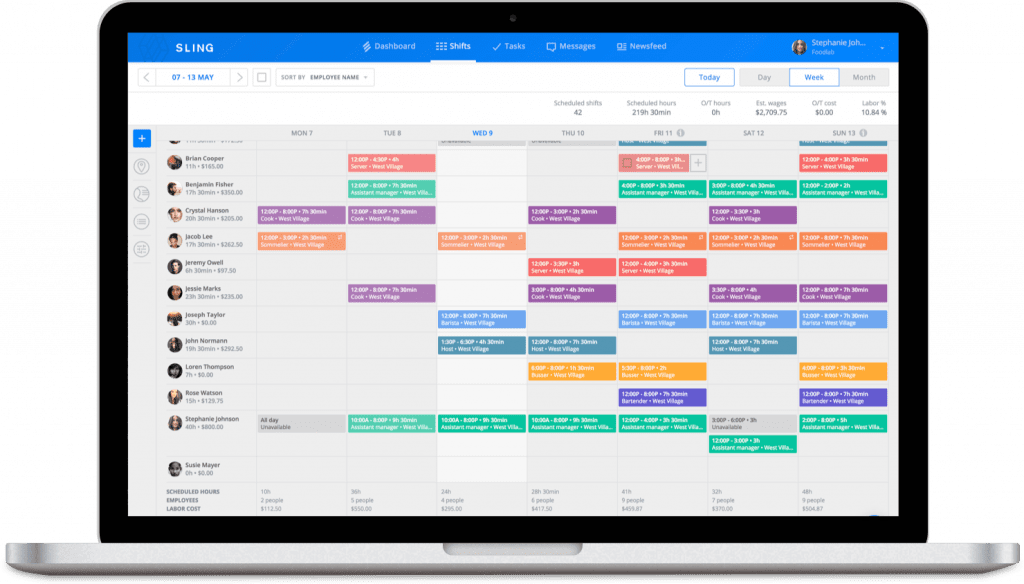Dislocated Worker: What Is It And Why Does It Matter
There are many essential business terms every good manager should know. Disloca...

If your business is facing an unplanned or short-term staffing issue, hiring a contingent worker might be the perfect stop-gap solution.
But what exactly is a contingent worker? What are the benefits of hiring one? And how can you manage these temporary employees for best results?
In this article, the workforce-management experts at Sling will answer those questions and tell you everything you need to know to make hiring a contingent worker work for your business.

A contingent worker — also known as a freelancer, an on-call worker, an independent contractor, a member of the gig economy, and more — is a temporary “employee” hired to fill short-term gaps in your team or provide specific skills for a one-off project.
We put quotes around the word employee in the previous sentence because a contingent worker is more like a consultant than a full-fledged part-time or full-time team member (in the eyes of the IRS, at least).
Having said that, not every temporary employee is a contingent worker (again, according to the IRS and the federal government).
Seasonal workers and some interns are classified as official employees for tax and payroll purposes.
It can be confusing — the difference between a contingent worker, an intern, and a full-time employee — so we encourage you to talk to a tax professional or an attorney familiar with your business, and take a few minutes to read these articles from the Sling blog:

One of the major differences between a contingent worker and a permanent member of your team is that your business pays limited or no taxes to the temporary employee.
Freelancers and consultants are responsible for paying the portion of the tax that your business usually pays. You may have to pay a higher base wage, but your business won’t have the tax liability that comes with full-fledged employees.
Flexibility is vital for many businesses these days as they respond to the volatility of the market in which they operate. Hiring a contingent worker provides a significant amount of flexibility to the way your business operates.
The temporary nature of these employees means that you can scale your workforce up or down quickly to meet the demands of the market.
Being able to exercise such flexibility in the face of economic forces can mean the difference between success and failure for your business.
Benefits of one type or another are a major expense for most businesses.
Health insurance, 401k contributions, and other fringe benefits such as profit sharing, childcare, student loan payoff assistance, and many more can have a significant impact on your bottom line.
Though a contingent worker may negotiate a few benefits into their contract, for the most part, the only expense your business will have to contend with is payroll.
Another benefit of hiring a contingent worker is that you can take overtime completely out of the equation.
Overtime is another big expense — both in terms of time and money — for most businesses. But a temporary employee such as a freelancer or consultant works under a different set of rules that doesn’t include overtime.
Of course, a contingent worker can negotiate overtime into their contract, but it’s not mandatory as it is for regular team members.
Hiring a contingent worker allows your business to secure experts with specialized skills for a specific project that you don’t need every day (or even every year).
For example, instead of taking the time and expense to train a unique skill — such as HTML programming or menu engineering — in an existing employee, your business can hire a contract worker to get the job done on an as-needed basis.

Before you hire a freelance or contract worker, sit down and add new policies to your employee handbook that address the unique nature of the tasks they’ll perform.
Be sure to include details such as:
Establish the foundation for contingent workers and then negotiate their individual contract from there.
Meetings are an important part of your team’s workflow.
Include your contingent workers in those meetings — be they face-to-face or virtual — to make them feel like valued members of your business.
Doing so serves many purposes. It will get them up and running faster, help them get to know their coworkers, give them an idea of how everyone works together, and help them get a feel for your company culture.
Company culture is a nebulous quality, even for you and your full-time employees. It’s even more nebulous for someone stepping into it for the first time.
Take the time to talk to contingent workers about such fundamental factors as:
Then encourage independent workers to abide by the company culture so that they feel less like outsiders and more like permanent members of the team.
Depending on the job for which you hire them, a contingent worker may be able to jump right in and get to work.
But to make the transition more successful, establish an onboarding process to get them acclimated to the way your business does things.
Easing them into the workflow will make them feel welcome and less overwhelmed by the new work environment.
A great way to do this is to create an onboarding checklist and make it available to your contingent worker before their first day so they know what to expect.
The payroll procedure for contingent workers will be different from the one for your regular employees.
Rather than trying to figure it out on the fly — which is a recipe for disaster — take some time before you hire them to investigate the laws and regulations that govern how they get paid.
Set up a standard payroll procedure in your employee handbook, and then go back and tweak it if you find a better way later or they request it be done differently (within reason, of course).

Because a contingent worker may only work in your business for a few days, weeks, or months, creating an accurate schedule can be extremely difficult.
But the temporary nature of these gig employees makes it all the more important to perfect their schedule right away so you (and they) can maintain focus, productivity, and engagement for as long as they’re part of your team.
If you’re a manager or owner, we don’t have to remind you that scheduling your regular employees is difficult enough. Adding a contingent worker into the mix can make it a real headache.
The Sling app is here to help.
The Sling suite of tools is perfect for creating even the most difficult types of schedules and incorporating a contingent worker into your team’s workflow because it offers features that other programs don’t.
Features of the Sling app include:
The Sling app even incorporates onboard artificial intelligence that warns you when conflicts arise and then suggests solutions.
Try Sling for free to discover the myriad ways it can help streamline the way you schedule everyone on your team (even a contingent worker) and how it can take your business to the next level.
For more free resources to help you manage your business better, organize and schedule your team, and track and calculate labor costs, visit GetSling.com today.
See Here For Last Updated Dates: Link
This content is for informational purposes and is not intended as legal, tax, HR, or any other professional advice. Please contact an attorney or other professional for specific advice.
Schedule faster, communicate better, get things done.